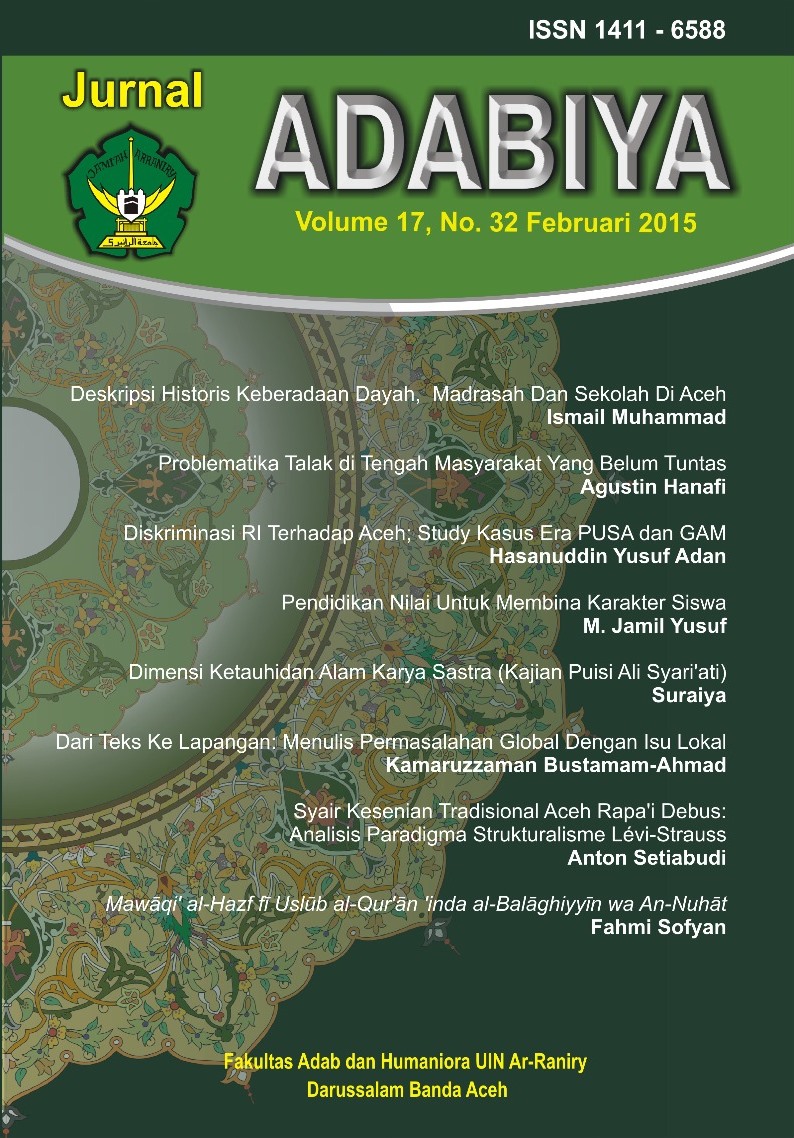References
Ali Hasjmy, Pedoman Umum Adat Aceh, Edisi I, Banda Aceh : Lembaga Adat dan Kebu- dayaan Aceh, 1990.
Alwahidi Ilyas, Budaya Aceh, Banda Aceh : Dinas Kebudayaan dan Pariwisata Aceh, 2009.
A. Rani Usman, Sejarah Peradaban Aceh, Suatu Analisis Interaksionis, Integrasi, dan Konf- lik, Jakarta: Yayasan Obor Indonesia, 2003.
Bogok Suyanto, Metode Penelitian Sosial; Berb- agai Alternatif Pendekatan, Jakarta : Ken- cana, 2008.
Burhan Bungin, Metodologi Penelitian Kualita- tif, Jakarta : Raja Grafindo Persada, 2006.
, Metode Penelitian Kuantitatif, Jakar- ta : Kencana, 2006.
Conny R. Semiawan, Metode Penelitian Kuali- tatif, Jakarta : Grasindo, 2010.
Departemen P & K, Kamus Besar Bahasa Indo- nesia, Jakarta: Balai Pustaka, 1990.
D. Akhmad, Pengantar Antropologi, Bandung: Amico, 1981.
Eksposa, Majelis Adat Aceh Provinsi Nanggroe Aceh Darussalam, MAA Provinsi NAD : Se- jahtera Perdana Ofiset, 2003.
Hasan Alwi, dkk, Kamus Besar Bahasa Indo-
Isjoni, Pendidikan Sebagai Investasi Masa De- pan, Jakarta : Yasasan Obor Indonesia, 2006.
Judi Achjadi, Pakaian Daerah Wanita Indone- sia, Djambatan : 1974.
Muhammad Husen, Adat Aceh, Banda Aceh : Di- nas Pendidikan dan Kebudayaan, 1970.
Muhammad Idrus, Metode Penelitian Ilmu So- sial, Yogyakarta : Erlangga, 2009.
Muhammad Liyansyah, Rondang Bintang Wisata Etnografi Tahunan Simalungun, Banda Aceh: Balai Pelestarian Nilai Bu- daya, 2011.
Muhammad Umar (EMTAS), Peradaban Aceh (Tamaddun) I, Banda Aceh: CV. Boebon Jaya, 2008.
Mahmut Tammat dkk., Seni Rupa Aceh, Banda Aceh : CV. Sepakat baru, 1996.
M. Jakfar Puteh, Sistem Sosial Budaya dan Adat Masyarakat Aceh, Banda Aceh: Grafindo Litera Media, 2012.
Nasruddin Sulaiman, dkk, Aceh Manusia Mas- yarakat Adat dan Budaya, Banda Aceh : Pusat Dokumentasi dan Informasi Aceh, 1992
, Pakaian dan Perhiasan Pengan- tin Etnis Aceh, Banda Aceh: Departemen Pendidikan nasional, 2000.
Radius, dkk, Adat Perkawinan Etnis Singkil (Hasil Observasi), Banda Aceh : Dinas Ke- budayaan dan Pariwisata, 2008.
Syamsuddin Daud, Adat Meukawen (Adat Per- kawinan Aceh), Banda Aceh : CV. Boebon Jaya, 2013.
Sugiyono, Memahami Penelitian Kualitatif,
Bandung : Alfabeta, 2012.
nesia, Edisi Ketiga, Jakarta: Balai Pustaka, , Metode Penelitian Kuantitat-
H. Badruzzaman Ismail, Sistem Budaya Adat Aceh dalam Membangun Kesejahteraan, Banda Aceh : CV. Boebon Jaya, 2013.
if, Kualitatif dan Reseacrh dan De- veloment, Bandung: Alfabeta, 2006.
T.H. Faisal Ali, Identitas Aceh Dalam Perspektif
ADABIYA, Volume 20 No. 1 Februari 2018 11
Nasruddin AS
Syariat & Adat, Banda Aceh: Badan Arsip dan Perpustakaan Aceh, 2013.
T. Ibrahim Alfian, dkk, Adat Istiadat Daerah Provinsi Daerah Istimewa Aceh, Proyek Pe- nelitian dan Pencatatan Kebudayaan Daer- ah, Banda Aceh: 1977/1978.
Zakaria Ahmad, Pakaian Adat Tradisional Daerah Propinsi Istimewa Aceh, Banda Aceh: Departemen Pendidikan dan Kebu- dayaan Aceh, 1986.



